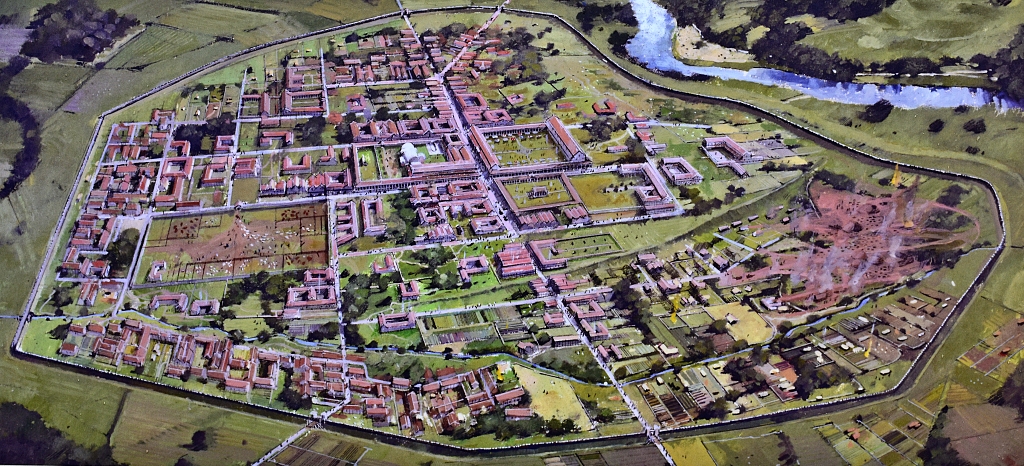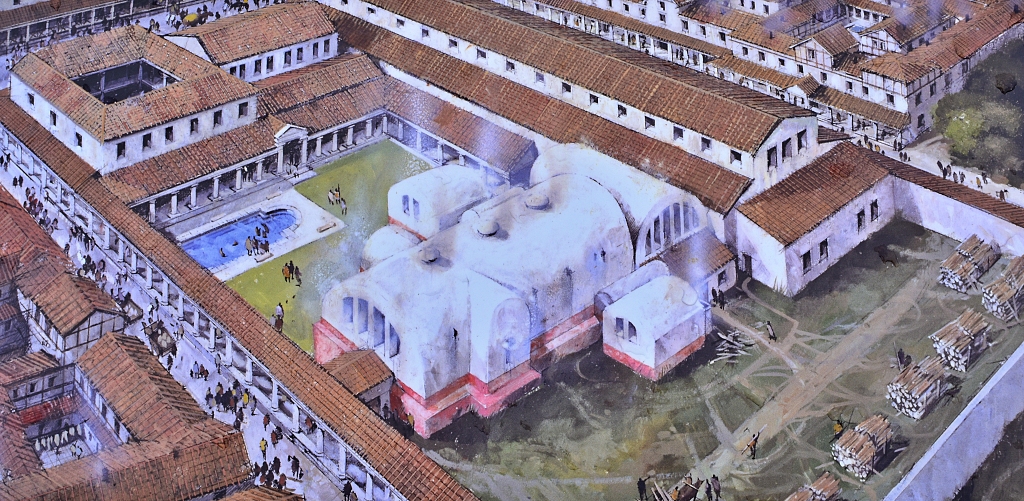Wroxeter Roman City
Vinconium Comoviorum
I enjoy a good Roman site and when I saw Wroxeter in our English Heritage handbook, we decided that Shropshire would be our next holiday destination. I get the impression that the Romans were just so far ahead of the times. The richer Romans had nicely decorated homes with underfloor heating systems, pools and saunas, and aqueduct and pipe systems to bring water into the home. It seems so civilised compared to the way I believe the wealthier rulers of England would have been living at the time. The local people were the Cornovii and like most Iron Age tribes they would have lived in windblown, chilly hill top forts and small farmsteads.
Wroxeter Roman City, or Viniconium Comoviorum as it was known then, was one of the largest towns in Roman Britain. It started life around mid-first century as a legionary fortress along the main Watling Street, which connected Dover to London to St Albans, and finally to Wroxeter. The site was well protected by the River Severn and natural streamed valleys. It also allowed the Romans to control the ford crossing on the River Severn. Just to add some scale as to the size of the fortress, a legion would have contained around 5000 foot soldiers, and over the years tradesmen and their families would also start living around the fortress. Towards the end of the first century, the Roman army left Wroxeter to relocate to Chester. Before leaving, they flattened the defences but left many of the buildings intact, and these buildings became the heart of the new town.
 Artists Impression of Wroxeter Roman City (photo taken of an English Heritage information board)
Artists Impression of Wroxeter Roman City (photo taken of an English Heritage information board) © essentially-england.com
The town council - yes, the Romans had such things! - would have included army veterans and local aristocrats. The council had plans to develop the town and raised taxes to fund them. The Forum was completed around the year 129/30, and approximately 10 years later Wroxeter also boasted a stunning public bath complex. It's the remains of this bath complex that you can discover today.
 Artists Impression of Wroxeter Bath Complex (photo taken of an English Heritage information board)
Artists Impression of Wroxeter Bath Complex (photo taken of an English Heritage information board) © essentially-england.com
Let's Explore Wroxeter
 The Road Outside Wroxeter Bath Complex
The Road Outside Wroxeter Bath Complex © essentially-england.com
The Romans had a thing about baths.
Bathing, in Roman Britain, wasn't just about cleanliness. Instead, the baths were a place to meet friends and socialise, exercise, and possibly get a shave or haircut. The bath house had cold and warm water baths, and hot and cold rooms like a modern-day sauna. Bathing was also about keeping healthy, and so doctors would also have been available.
To help visitors imagine the town better, the conservationists at Wroxeter have helpfully colour-coded areas using different materials.
Outside the bath complex, the Roman road is marked out in grey gravel.
The fine red gravel would have been a covered pavement. Markers in the gravel show the location of the posts that supported the roof.
Beyond that, you have the outside wall of the complex, and once inside the building, yellow sand marks the exercise & warm-up area, in which you will also see markers that show the positions of columns that supported its roof.
This beautiful 7-metre-tall bit of wall has been given the name “The Old Work”. The holes in the wall are from the scaffolding used to build it and are called “put-log holes”.
I think it’s amazing that this piece of wall has survived over 1800 years!
There would have been wooden double doors in the opening that led through to the unheated room of the baths, called a frigidarium.
This was one of the first rooms a bather would enter.
 Remaining Wall of Wroxeter Bath Complex
Remaining Wall of Wroxeter Bath Complex © essentially-england.com
From the frigidarium, they'd move into the main bath complex. On the left - in the grey floored area - are the warm and hot steam rooms with remains of the hypocaust floor. Various other rooms include plunge pools, furnaces, and further warm rooms.
 View Over the Bath Complex © essentially-england.com
View Over the Bath Complex © essentially-england.comA later addition to the bath complex was an outdoor pool. The water in this was not heated. This may be fine during a warm summer, but you would have to be brave to enter during the colder winter months!
 The Outdoor Bathing/Plunge Pool © essentially-england.com
The Outdoor Bathing/Plunge Pool © essentially-england.comAfter spending the morning bathing, you may want to visit the market hall in the afternoon to buy food after your exertions in the baths. The rents paid by the vendors would have helped to pay the costs of running the bathing complex. And opposite the market hall was The Forum, where the townsfolk met to discuss politics and local affairs... networking Roman style!
 Wroxeter Market Hall © essentially-england.com
Wroxeter Market Hall © essentially-england.com
Wroxeter Recreated Town House
In 2010, a group of six builders and a few volunteers set out to build a Roman town house using tools that would have been available in Roman times. The design was based on information gained from the excavation of a town house done at Wroxeter back in 1913/4. The house has a shop, study, reception/dining room, bedroom, a bathing suite, and slave quarters, granting us an intriguing look into the past.
 Images of the Recreated Town House at Wroxeter
Images of the Recreated Town House at Wroxeter © essentially-england.com
 Images of the Recreated Town House at Wroxeter
Images of the Recreated Town House at Wroxeter © essentially-england.com
 Images of the Recreated Town House at Wroxeter
Images of the Recreated Town House at Wroxeter © essentially-england.com
 Images of the Recreated Town House at Wroxeter
Images of the Recreated Town House at Wroxeter © essentially-england.com
What Happened to Wroxeter?
By the end of the second century, with all civil building work completed and defences built, Wroxeter was probably at its peak. Historical research has found over 250 buildings and many more have been detected, but not excavated. A rough estimate is that between five and ten thousand people may have lived in Wroxeter.
For five centuries, the town first flourished, and then declined, before being abandoned in the early seventh century.
Events that may have contributed to Wroxeter being abandoned:
1) The Roman Empire weakened until it finally collapsed in the late fifth century.
2) The Plague ravaged England in the mid sixth century.
3) The Anglo-Saxons took control of the area in the early seventh century.
If you would like further information about Wroxeter Roman City, then please visit the English Heritage website. And if you visit Wroxeter make sure you take one of the audio guides as it was very good and brought the site alive.
A detailed visitors guidebook is available.
Wroxeter Roman City Guidebook
Are You Planning a Trip to Shropshire?
Shropshire is a marvellous place for history and food lovers! There's so much to see and do and taste, that you'll need more than just a short visit. If food is your thing, head to Ludlow and start exploring from there. For history lovers, Shrewsbury makes a great base with many historical sites in very easy reach.
Where You Could Stay
To see more self-catering cottages in Shropshire click here or check out holiday cottages in other parts of England by clicking here.
If you need to find a hotel, then try one of these search platforms...
What You Could See and Do
Here are a few places that should go on your must-see list:
- Wroxeter Roman City
- Shrewsbury Abbey
- Shrewsbury
- Attingham Hall and Parkland
- Cantlop Bridge
- Snailbeach Mine
- Much Wenlock
- Offa's Dyke
- Ironbridge Gorge, The Iron Bridge & Broseley Jitties
- Ludlow Castle
- Stokesay Castle
- Bridgnorth
Click here for a great list of things to do in Shropshire.
If you have enjoyed reading about Wroxeter Roman City and are looking for other ideas for days out, then please click here to explore our Shropshire page.










